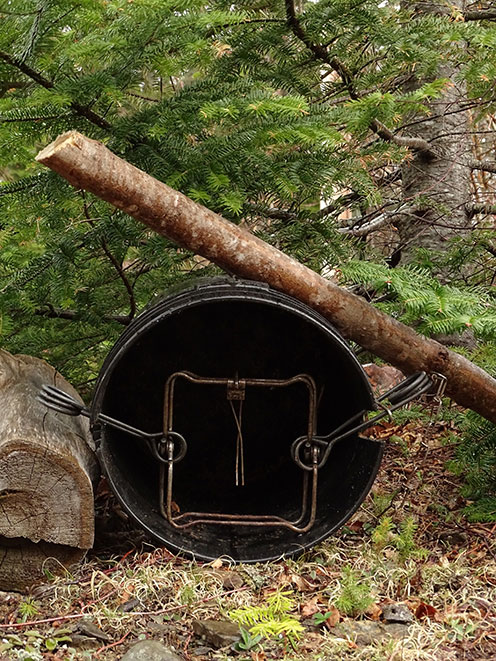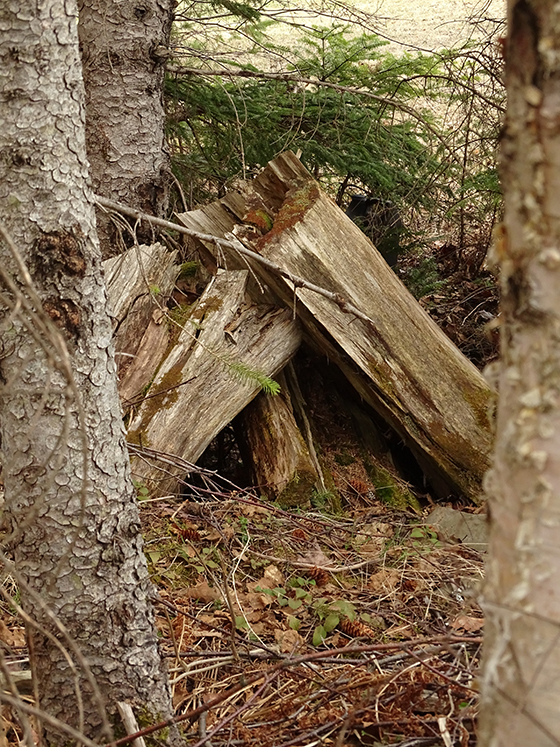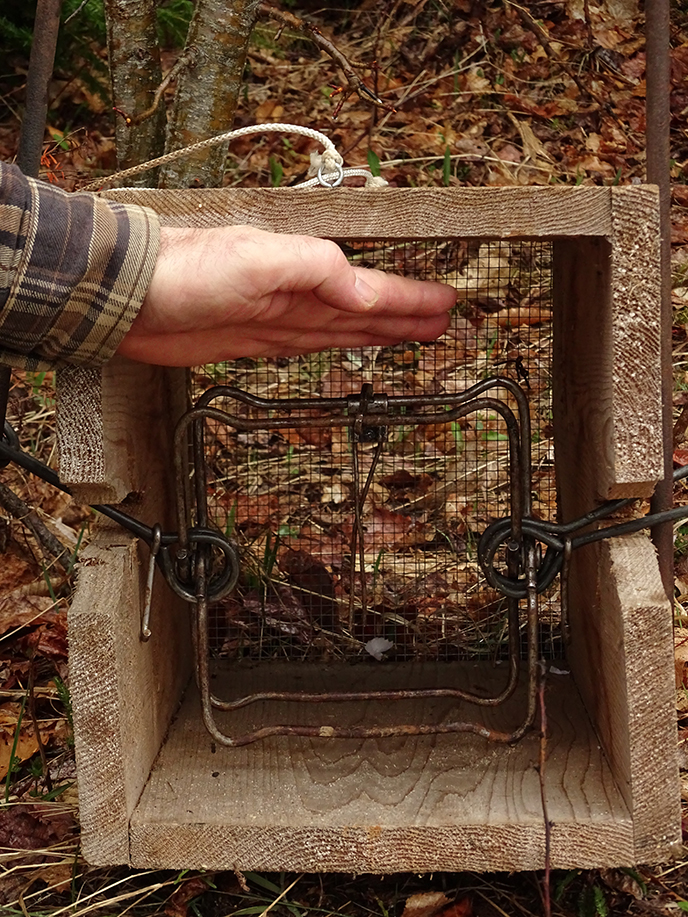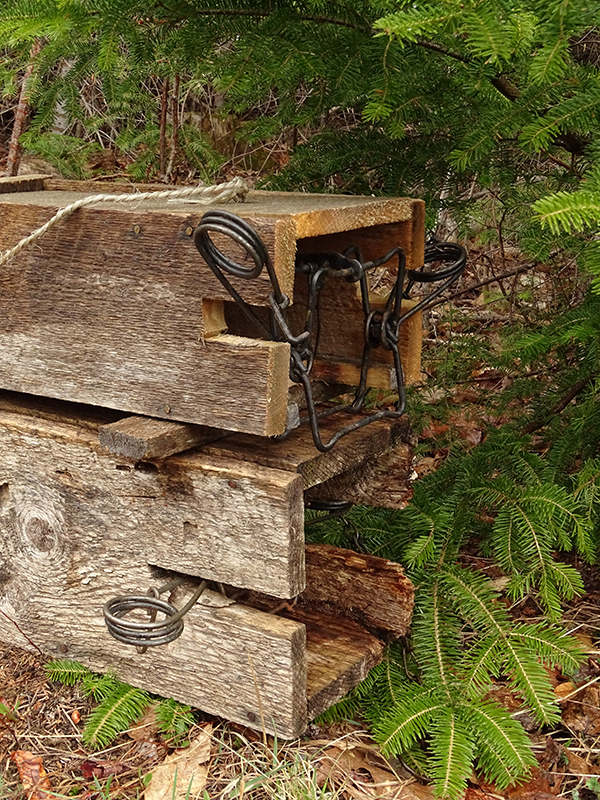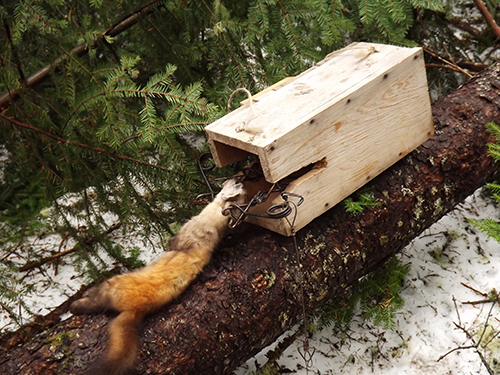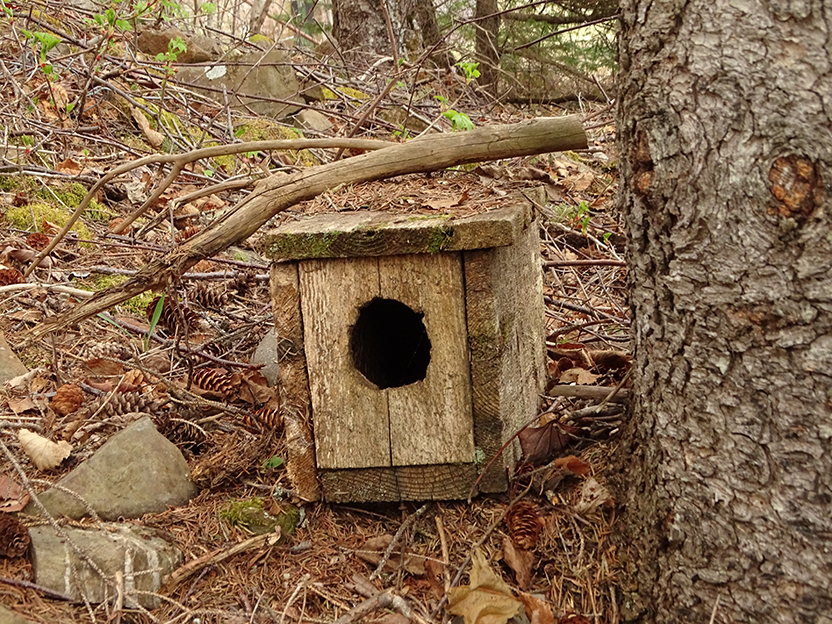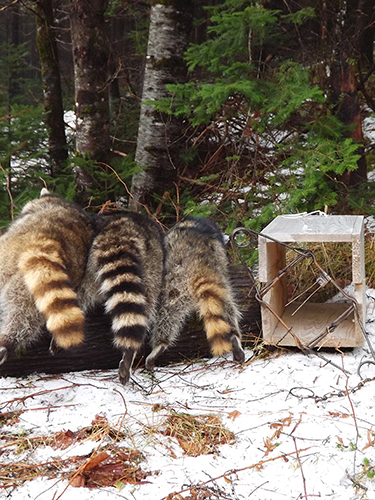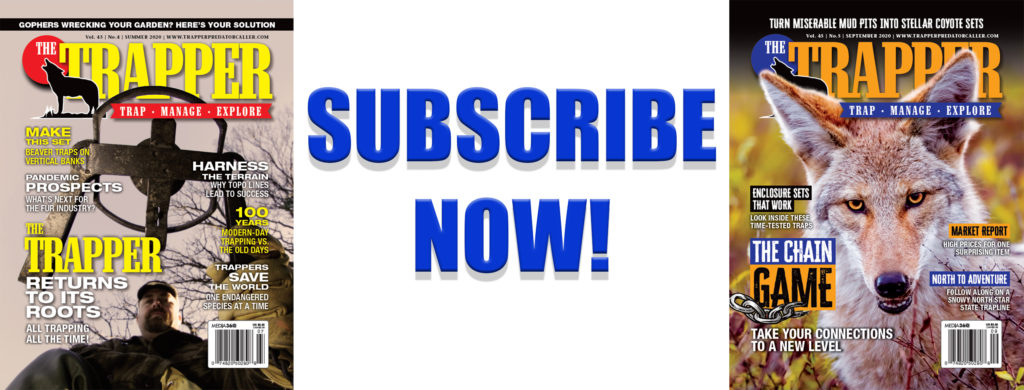An examination of enclosures and the pursuit of cubby perfection.
By Cary Rideout
A cubby of one sort or another is part of almost every trapper’s tool kit, and for good reason. Well-made, properly guarded cubbies can be counted on to function through the most difficult of conditions. However, for this type of set to perform effectively, some serious consideration is in order long before installing that first trap.
Definitions
So just what is a cubby? It is pretty much whatever the builder decides to create, because like all good tools, a cubby is adaptable for many situations. In our trade a cubby is an enclosure, either man-made or natural, guarded with a restraining or lethal device. A properly constructed cubby must attract, hold the attention of and then control the target furbearer’s actions, eventually convincing the critter into the set to fire the trap or snare.
Yes, many cubby trappers use snares. A classic French Canadian cubby set was the lynx house, or Cabane. This was made by partially fencing around a large tree trunk with a semicircle of long poles leaning inward against the tree and baited with a varying hare. Enough space was left in the fence to allow a lynx to see the free lunch and search for a way in. An opening was left straight out from the bait, but blocked just enough so that the lynx had to step up into the house and set with a snare on a drag pole. Once hooked up, the feline would move away a short distance due to the drag, thus leaving the Cabane in ready-to-reset condition. Trappers still use this fine set modified for a foothold trap, because a good cubby design always works.
Correct location is important with any set and a skilled trapper knows just where the cubbies are going well in advance. Brooks, swamps and ponds are fine places to get a few buckets or boxes in. Old beaver works, abandoned rural structures and any cropland needs cubby scouting. Big timber where martens, fishers or bobcats hunt can be guarded with a mixed snare/cubby line. In fact, about the only time that I ever paused in setting a cubby was out in the middle of a cut grain field. It was a big, wide-open section and smack dab in the middle I struck raccoon sign. Part of my trap permissions had been to agree to nail the bandits hard, and after some thinking I staked a bucket in with a #160. I wasn’t worried about thievery and was more curious then anything. Would you believe it was hit three times? While it’s doubtful that I’ll ever trap the prairies, at least I know a cubby will work in the big wide open.
Beginnings
Cubbies have been catching fur or food since long before iron appeared back when wooden deadfalls or leather snares guarded sets. As materials improved, the cubby used metal, and the catching really took off. Enclosures were constructed for various fur targets and we still employ many of the designs. Old time bear trappers built very elaborate cubbies traditionally 3 feet wide and 5 feet long, and low enough to coax a bruin into the large iron traps. Early on in my career I encountered a few old examples — all low, narrow and deep enough to encourage anyone following their nose to see what was inside. And while on the subject of old cubbies, if you locate a long unused pail or box, be sure to get a fresh one right there. If it worked 20 years ago, it will work this season.
Why does the cubby continue to be such a fur producer? Wildlife biologists tell us that many furbearers begin life in a hollow, dark place so it seems natural to find this safe and not dangerous. Over their lifetime, food sources can be found down under a log or in cave-like locations, so it’s instinct to investigate each one encountered.
Many trappers rely heavily on what I call wild cubbies, the ones made from what’s at hand. Modifying nature can produce a dandy trap set in short order that will interest a range of fur targets. When summer scouting be on the lookout for any natural hollows, rocky sections or stream overhangs that can be altered. Carry a trap spade and hatchet to improve and excavate a little for a superior location. My Grandfather Rideout, in his days along the Crooked Knife Trail, carried a stubby hand auger and a 2-inch wood chisel to modify woodpecker holes for sable or weasel traps.
Upgrading a Classic
No cubby has ever lost the influence of the humble bucket — regardless of its pedigree. The first bucket cubby I ever encountered decades ago was a tin lard pail. Pretty soon the country was full of Golden Brand lard buckets, and some wicked catches came from those early killer trap cubby sets. So much so that more than one square-steel doubter had to quickly join the bodygrip fraternity or risk a slim catch. Despite the years, we still turn to the reliable pail cubby and its close cousin, the wooden box.
For most trappers running steel today, a cubby is generally a bucket or wooden box, but to be an effective tool you must harness the possibilities. A good rule of thumb for any bucket cubby is sufficient depth, and I like to use the full-size, round 5-gallon or 25-liter style, and the large square type of more than 20 liters. These have enough length to cut slots well down inside of 6 inches. The same goes for the wooden boxes, build them long so that the investigator is deep and committed. Foothold cubbies also need to be narrowed so that the target sets a paw down in place. Use a few stones or a couple of short broken sticks to gently edge them onto the pan. Think of it as a dirthole on its side, and work accordingly.
Proper slot cutting is crucial for a cubby to perform, and while many bucket builders simply slice out two cuts, a little more thought is needed. When setting up a series of buckets, think about this — are your notches at the same level, equal in depth and long enough to bring the target well into the set before firing? Try to get the notches to center your trap perfectly and not be off kilter. A crooked angled set of any kind will be problematic at the worst possible times. The advantage to any slotting is to get the springs pushing hard back, and then out throwing the square over the target for a lethal connection behind the ears. While you are measuring be sure your cuts can work with your particular trap models. Some killer traps today have different spring safeties that need to be considered before cutting begins.
Not all trap sizes work with all buckets. The 6×6 killer traps with lower frames and shorter springs might not fit every bucket like a 7×7 does. A large 5-gallon bucket, with its wide opening allows too much room around the #160. Do some hard looking before mixing models and buckets because the trap must fill the opening with little space for pesky paws. Even a wood cubby should have just enough room for traps to fit in and sit tight.
Next to notching, stabilization is equally important. No cubby works if it can be rolled or tipped over, and a trap bucket destabilized is effort wasted. Again, it can be remedied with a rock or maybe a couple logs, but why not work like the pro you are? I know many of you just crank up the springs and say that will hold it, but this never seems trustworthy to me. A wise operator will have precut metal or wooden stakes that can pull double duty as cubby and trap stabilizers. Why not drill a couple holes midway down through a bucket and drive your stabilizers in?
After a cubby is solid, scent and bait are next. With the far-calling scents available on the market today, I apply scent to a nearby tree trunk chest high for maximum dispersal, regardless of target species. Many bucket trappers drill 1/2-inch holes in the bottom to let out scent, or if using a wooden box, install a wire mesh “window” to allow supper to waft out. Both work well but I’d rather keep the attention up where the trap is waiting.
Baiting a cubby can lead to a problem — and you know what I’m talking about. Bait thievery. Few things are as aggravating as finding the set vandalized, the bait missing or worse, gripped in the jaws with indications a valuable pelt arrived afterward. Liquid baits can be used and leave nothing for thieves. A large tin can will hold enough tempting juice to pull any fur in for a snoot full.
Screw the bait can into a wooden base and attach this inside the enclosure so that nothing moves. But, for most fur hunters, something meatier is in order. A wire mesh divider can be installed or even a spike can hold the grub in place.
What about a suspension device? First off, bag up your favorite meat bait in mesh onion sacks. Next, set the cubby in position then drill a hole down from the top, 4 inches from the back. Then run trap wire down inside and loop it around the bait sack. Be sure it can’t be pulled into the trap jaws. Use a stout stick or section of old pipe to hang the wire from outside, or better yet, install an eye bolt.
Perfection Isn’t Perfect
Despite all of the sunny talk there’s bound to be a little trouble. Buckets can be a problem to handle in numbers and worse still, wooden cubby boxes won’t nest well and take up serious space on setting day. But here’s a thought, pails stack well, so why not use this feature rather than fight it? Drill a hole through each bottom and thread a 1/4-inch rope through them to make a sling to carry half a dozen comfortably as you walk. An extra pail in your other hand can be the bait and trap holder, giving you seven, which is a good line.
Buckets or boxes just scream, “Hey, I trap!” But if you wish to keep operations undercover, use a large feed bag to conceal your cubbies from the curious. Wooden boxes can also be spread across an ATV front or rear parcel carrier in bags for concealment, and a truck box can hold several bags of boxes. Have trouble carrying wooden cubbies? Take a couple screw eyes or even old fence staples, nail one on each end of the box and run a cord to make a handy hauling strap. An old frame pack board can also be modified to haul boxes.
One problem that a wild cubby of any sort often suffers from is secret entrance syndrome. This is when you prepare a natural cubby, only to find the bait removed or a spot dug out where a freeloader spoiled your set. Any wild cubby needs careful attention, so be sure that all access is closed off. Why fur likes digging and scratching when the wide-open entrance is right there still baffles me, but it must just be in their nature.
Another annoying fact of any cubby line here in my district is the occasional coyote snoopers. These clowns come in circling a few times, drop a coil calling card and run off laughing. This pestered me for a few season until another fellow advised me to build a few rough fences of brush and hang snares. Duh! Of course, this solved most of the problems and added to the fur take, as well.
Oddball Yes, But Effective
Trappers are pretty sharp at coming up with off-the-wall ideas and smart cubby operators see potential everywhere.
Sections of discarded drainage pipe or fuel barrels can be adapted into unusual and effective cubbies. Old plastic pipe with a diameter of 6 to 8 inches turn up around woods operations, farms or even road construction. These can be shortened to a couple feet and slotted, making for a very durable set just about invisible once in place. Even narrow, 4-inch PVC pipe can make a cubby just right for mink or muskrat along a waterway. Old discarded fuel barrels can turn up just about anywhere. For some reason they are a major attracter with regular visits from all of the fur travelling past. Tough, but not impossible, you can cut fuel barrels no matter their size and they’ll last for decades.
Farm country has all sorts of oddball cubby material just waiting for bait and trap. Old maple sap cans, assorted liquid containers and even packing crates can be pressed into service for a cubby. You know you are getting the hang of this when you trap fur in a car tire cubby or an old bath tub, so get creative.
“Good methods yield honest returns, while poor ones lead to bankruptcy,” a trapping veteran once told me. It’s solid advice for any trapper, no matter if the line is three miles or three hundred. Careless preparation and poor designs always come back to remind you of what you should have done in the first place. A cubby is what you decide and if it puts fur on the forms, well that’s the real proof.
